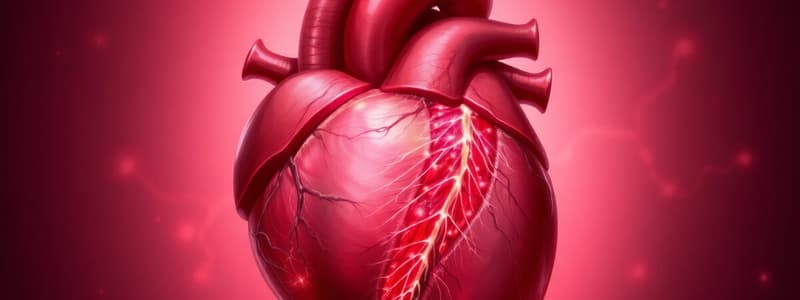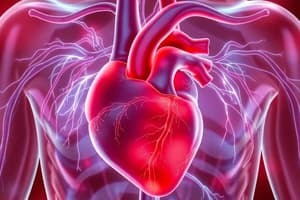Podcast
Questions and Answers
What is the normal outcome of the ductus arteriosus after birth?
What is the normal outcome of the ductus arteriosus after birth?
- It becomes a valve that regulates blood flow.
- It undergoes hypertrophy and functions as an artery.
- It remains patent throughout life.
- It closes within hours, forming the ligamentum arteriosum. (correct)
What condition results from the failure of the ductus arteriosus to close?
What condition results from the failure of the ductus arteriosus to close?
- Ventricular septal defect
- Patent ductus arteriosus (correct)
- Congenital heart failure
- Acute respiratory distress syndrome
Which of the following statements regarding the ductus arteriosus is correct?
Which of the following statements regarding the ductus arteriosus is correct?
- It supplies blood to the liver during fetal development.
- It is a temporary blood vessel that connects pulmonary and systemic circulation. (correct)
- It is a permanent fixture in the cardiovascular system.
- It remains open after birth to ensure adequate oxygen supply.
What anatomical structure does the ductus arteriosus become after it closes?
What anatomical structure does the ductus arteriosus become after it closes?
How long after birth should the ductus arteriosus typically close?
How long after birth should the ductus arteriosus typically close?
What is defined as the reduction in luminal diameter in valvular defects?
What is defined as the reduction in luminal diameter in valvular defects?
Which term describes the heart's adaptive response to stress or damage?
Which term describes the heart's adaptive response to stress or damage?
Which condition is characterized by insufficient valve closure leading to backflow of blood?
Which condition is characterized by insufficient valve closure leading to backflow of blood?
Which of the following is NOT a type of valvular defect?
Which of the following is NOT a type of valvular defect?
What best describes dysplasia in the context of heart valves?
What best describes dysplasia in the context of heart valves?
What is the primary characteristic of lymphangitis?
What is the primary characteristic of lymphangitis?
Which condition is closely related to lymphatic system issues?
Which condition is closely related to lymphatic system issues?
Which anatomical feature is primarily affected by lymphangitis?
Which anatomical feature is primarily affected by lymphangitis?
What is a potential consequence of untreated lymphangitis?
What is a potential consequence of untreated lymphangitis?
Which of the following statements regarding lymphangitis is accurate?
Which of the following statements regarding lymphangitis is accurate?
What is a primary characteristic of sclerosis in the vascular system?
What is a primary characteristic of sclerosis in the vascular system?
Which of the following phenomena is associated with the vascular system in relation to sclerosis?
Which of the following phenomena is associated with the vascular system in relation to sclerosis?
What effect does sclerosis have on arteries?
What effect does sclerosis have on arteries?
Which of the following statements is true regarding the changes in the vascular system due to sclerosis?
Which of the following statements is true regarding the changes in the vascular system due to sclerosis?
How does the loss of elasticity in arteries due to sclerosis affect blood flow?
How does the loss of elasticity in arteries due to sclerosis affect blood flow?
What are the main microscopic features observed in cases of suppurative pericarditis?
What are the main microscopic features observed in cases of suppurative pericarditis?
Which gross feature indicates the presence of fibrin deposits in the pericardium?
Which gross feature indicates the presence of fibrin deposits in the pericardium?
What is the primary cause of traumatic reticulopericarditis in cattle?
What is the primary cause of traumatic reticulopericarditis in cattle?
Which feature is characteristic of pathogenic changes in the pericardial sac during suppurative pericarditis?
Which feature is characteristic of pathogenic changes in the pericardial sac during suppurative pericarditis?
What is a common source of the foreign bodies causing traumatic reticulopericarditis in cattle?
What is a common source of the foreign bodies causing traumatic reticulopericarditis in cattle?
Study Notes
Patent Ductus Arteriosus
- The ductus arteriosus is a blood vessel that connects the aorta and pulmonary artery in the fetus.
- It allows blood to bypass the lungs, which are not yet functional.
- After birth, the ductus arteriosus should close, usually within a few hours.
- If the ductus arteriosus remains open after birth, it is referred to as a patent ductus arteriosus.
- This can lead to a number of complications, including heart failure.
Valvular Defects
- Stenosis: A narrowing of the valve opening, which restricts blood flow.
- Dysplasia: An abnormal development of the valve, which can lead to insufficiency (inability to close properly).
Suppurative Pericarditis
- An inflammation of the pericardium (the sac that surrounds the heart) caused by bacteria.
- Characterized by the accumulation of pus within the pericardial sac.
- Typically caused by foreign bodies (e.g., nails, wire) that penetrate the reticulum (a part of the stomach in ruminants) and enter the pericardial sac.
- Grossly, the pericardium appears thickened, white, and rough.
- Thick, foul-smelling pus is often present within the pericardial sac.
Sclerosis of the Arteries
- Hardening of the arterial wall, which reduces elasticity and lumen size.
- Often seen in older animals, or those with certain health conditions (e.g., diabetes).
Lymphangitis and Lymphontitis
- Lymphangitis is an inflammation of the lymph vessels.
- Lymphontitis is an inflammation of the lymph nodes.
- Both conditions can occur as a result of infection.
Right Atrium
- The right atrium is one of the four chambers of the heart.
- It receives deoxygenated blood from the body.
- The right atrium is often described as "brown" due to the presence of pigments, especially in elderly animals.
Studying That Suits You
Use AI to generate personalized quizzes and flashcards to suit your learning preferences.
Related Documents
Description
This quiz covers key concepts related to patent ductus arteriosus, including its function, complications, and the normal closure process after birth. Additionally, valvular defects and suppurative pericarditis are examined, focusing on their definitions and implications. Test your knowledge on these important cardiac conditions.




